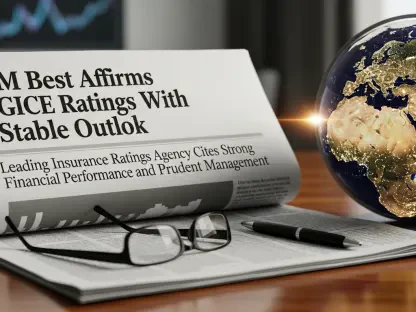In the dynamic world of entrepreneurship, small business owners chase growth and innovation with relentless passion, yet many unknowingly leave themselves vulnerable to devastating financial risks by neglecting a vital protection: professional liability insurance. Commonly known as Errors and Omissions (E&O) coverage, this safeguard is often absent among freelancers, contractors, and microbusinesses, creating a dangerous gap that could unravel years of hard work in an instant. This oversight isn’t merely a personal misstep; it reflects a broader systemic challenge within the insurance industry, where misunderstandings about coverage types and inadequate guidance exacerbate exposure. As the landscape of work evolves with more individuals stepping into independent roles, the absence of proper protection against professional errors becomes increasingly alarming. This issue demands attention, as the consequences of being uninsured for such risks can be catastrophic, threatening not only individual livelihoods but also the stability of the broader small business ecosystem.
Understanding the Coverage Gap
Misconceptions About General Liability
A pervasive myth among small business owners is that General Liability (GL) insurance offers a complete shield against all potential risks, a belief that leaves many dangerously exposed to professional liability claims. GL policies are often required for access to job sites or contracts, leading owners to assume they are fully protected. However, these policies primarily cover physical damages, such as property harm or bodily injury, and do not extend to errors in professional services like flawed advice or misinterpretations of data. This misunderstanding is particularly prevalent among those who rely on GL as their sole form of insurance, unaware that a single mistake in a consultative role could lead to costly lawsuits. The gap between expectation and reality is stark, as financial losses from professional missteps can quickly spiral out of control without the right coverage in place, highlighting a critical blind spot for many entrepreneurs.
This misconception is compounded by a lack of clarity in communication within the industry, where the nuances of coverage types are not always explained effectively to clients. Small business owners, especially those new to running their own ventures, may not have the time or resources to research insurance details independently, relying instead on assumptions or incomplete advice. For instance, a contractor might believe that GL insurance protects against all job-related risks, only to discover after a claim that professional errors—such as incorrect project specifications—are excluded. This gap in understanding often results in severe financial strain, as legal fees and settlements can drain resources rapidly. Addressing this knowledge deficit is essential, as it underpins much of the underinsurance problem plaguing microbusinesses today, leaving them vulnerable at the very moment they need protection most.
Impact of Workforce Trends
The shift toward freelance and contract work has dramatically reshaped the professional landscape, significantly increasing the number of individuals exposed to professional liability risks without adequate safeguards. As more people move away from traditional employment to independent roles in sectors like technology, engineering, and oil and gas, they often lose access to employer-provided insurance, leaving them unprotected against claims related to their work. This trend is particularly concerning for those whose roles blend physical tasks with advisory responsibilities, creating ambiguity about where GL coverage ends and E&O coverage becomes necessary. The rise of the gig economy has only accelerated this shift, with countless professionals operating without realizing the full scope of their risk exposure, a situation that can lead to devastating consequences if a professional error occurs.
Moreover, the diversity of industries affected by this trend underscores the urgency of addressing the coverage gap, as risks are not confined to a single sector but span a wide array of professions. In fields where consultative work is common, such as project management or IT services, the likelihood of facing a claim for negligence or errors in judgment is heightened. Yet, many independent workers in these areas remain unaware that their previous corporate safety nets no longer apply, mistakenly assuming personal GL policies cover all bases. This growing pool of at-risk professionals represents a significant challenge for the insurance industry, which must adapt to meet the needs of a workforce that is increasingly fragmented and self-reliant. Failure to address this evolving dynamic risks leaving countless small business owners exposed to liabilities they cannot afford to bear.
The Role of Brokers in Bridging the Gap
Education as a Key Solution
Insurance brokers serve as the frontline advisors for small business owners, yet many fall short in clarifying the critical distinctions between GL and E&O coverage, contributing to widespread underinsurance. Often, brokers focus on fulfilling immediate client needs, such as securing GL policies for contract compliance, without delving into the broader spectrum of professional risks. This oversight can leave clients with a false sense of security, believing they are fully protected when, in fact, significant gaps remain. Enhancing broker education is paramount, as these professionals must be equipped to explain why E&O coverage is essential for anyone providing advice or specialized services. By fostering a deeper understanding among brokers, the industry can begin to dismantle the misconceptions that perpetuate this vulnerability among microbusinesses.
Beyond their own training, brokers must also take on the role of educators for their clients, ensuring that small business owners grasp the specific risks tied to their work and the limitations of standard policies. This involves breaking down complex insurance jargon into clear, actionable insights, helping clients see the value of investing in E&O coverage before a claim arises. For example, a broker might illustrate how a freelance consultant could face a lawsuit over flawed recommendations, a scenario not covered by GL insurance. Such conversations can shift client perspectives, moving them from viewing insurance as a mere formality to recognizing it as a vital component of business sustainability. Empowering brokers to lead these discussions is a crucial step toward closing the coverage gap, as informed clients are more likely to seek out the protections they truly need to safeguard their operations.
Communication Challenges and Opportunities
Another hurdle in bridging the insurance gap lies in the communication barriers that often exist between brokers and small business owners, particularly those new to navigating complex policies. Many clients lack the background to ask the right questions about coverage, while brokers may not always proactively address potential professional liabilities due to time constraints or competing priorities. This disconnect can result in missed opportunities to secure E&O policies, leaving businesses exposed to risks that could have been mitigated with a simple conversation. Improving communication channels, perhaps through streamlined resources or digital tools that outline coverage differences, could help brokers deliver critical information more effectively, ensuring clients are not left in the desk about their vulnerabilities.
Additionally, there is an opportunity for brokers to build stronger trust with clients by tailoring their approach to individual business needs, thereby fostering a more receptive environment for discussing E&O coverage. By taking the time to understand a client’s specific industry and role—whether it’s a contractor offering design input or a tech freelancer managing sensitive data—brokers can highlight relevant risks and propose customized solutions. This personalized engagement not only clarifies the importance of professional liability insurance but also positions brokers as indispensable partners in business protection. Strengthening these relationships can transform the way small business owners perceive insurance, turning it from a burdensome expense into a strategic asset, ultimately reducing the prevalence of underinsurance across diverse sectors.
Industry Innovations and Responses
Tailored Approaches for Microbusinesses
Amid the growing concern over professional liability gaps, certain insurance providers are stepping up with innovative strategies to target microbusinesses and non-buyers of E&O coverage, focusing on customization over one-size-fits-all solutions. Unlike larger entities that often rely on automated underwriting systems, some agencies prioritize human expertise, employing underwriters with deep industry knowledge to assess the nuanced risks of small businesses. This approach allows for more flexible and relevant products that address the specific needs of freelancers and contractors who might otherwise slip through the cracks. By crafting policies that reflect the unique exposures of these professionals, such providers are making strides in capturing an underserved market, offering a lifeline to those previously unaware of their vulnerabilities.
Equally important is the emphasis on education as part of these tailored strategies, with forward-thinking providers working to demystify insurance for both brokers and clients through accessible resources and direct engagement. This might involve workshops, detailed guides, or even personalized consultations that break down the differences between GL and E&O coverage, ensuring small business owners understand what they are buying and why it matters. Such initiatives aim to convert non-buyers into informed policyholders by highlighting real-world scenarios where professional errors could lead to financial ruin without proper protection. This dual focus on bespoke products and knowledge-sharing represents a significant shift in how the industry approaches microbusinesses, recognizing their distinct challenges and positioning education as a cornerstone of risk management.
Adapting to Economic Changes
The rapid rise of the gig economy has reshaped the economic landscape, compelling the insurance industry to evolve in response to the unique risks faced by an increasingly independent workforce. Traditional insurance models, often designed for conventional employment structures, struggle to accommodate the fluid nature of freelance and contract work, where professionals frequently shift between roles and industries. To address this, some insurers are developing more adaptable products that can be customized to fluctuating needs, ensuring coverage remains relevant as business models change. This flexibility is critical in a market where the boundaries of professional responsibility are constantly redefined, and it signals a broader industry acknowledgment that static policies are no longer sufficient.
Furthermore, raising awareness about professional liability risks must go hand in hand with product innovation, as many in the gig economy remain unaware of the specific protections they require. Insurers are beginning to partner with platforms and associations that cater to independent workers, using these channels to disseminate information about E&O coverage and its importance. By embedding education into the very ecosystems where freelancers operate, the industry can reach those most at risk at the point of need. This proactive stance not only helps close the coverage gap but also builds trust with a demographic that often feels overlooked by traditional financial services. Adapting to these economic shifts through both innovative offerings and strategic outreach is essential to protecting the growing number of small business professionals navigating today’s dynamic work environment.
Reflecting on Past Efforts and Future Steps
Looking back, the insurance industry took significant steps to address the professional liability gap by identifying the surge in freelance work and beginning to tailor solutions for microbusinesses. Efforts to educate brokers and clients gained traction, with targeted initiatives shedding light on the critical differences between GL and E&O coverage. Innovative underwriting practices emerged, driven by a commitment to flexibility and human expertise, allowing providers to meet the nuanced needs of an evolving workforce. These past actions laid a foundation for change, as the industry started to recognize the scale of underinsurance among small business owners and the economic trends fueling this vulnerability.
Moving forward, the focus should shift to scaling these efforts through broader collaboration between insurers, brokers, and industry platforms to ensure no professional is left unprotected. Developing digital tools that simplify policy comparisons and risk assessments could empower small business owners to make informed decisions independently. Additionally, advocating for standardized training programs for brokers on professional liability risks could create consistency in client advising. By continuing to innovate and prioritize awareness over the coming years, the industry can build a more resilient safety net for the gig economy, ensuring that every small business has the resources and knowledge to thrive without the looming threat of uncovered liabilities.









